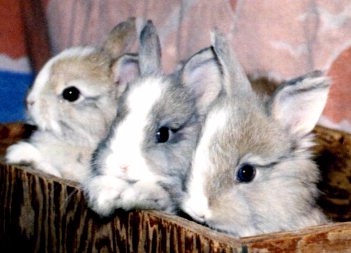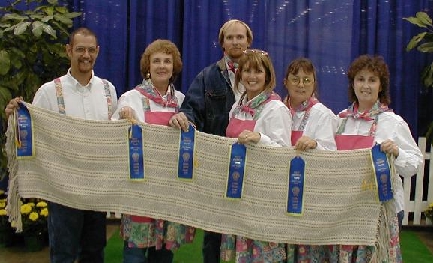My rabbit and spinning hobby started in 1972, on a farm in Ohio, with rabbits of mixed breeding, intended for our home meat production.
Shortly after, I saw an ad for the American Rabbit Breeders Association, and sent for a small informational booklet. In it, I learned of a whole new world. A world of many breeds, many sizes, many colors, and the most beautiful rabbit I had ever seen - an Angora.
An Angora trio was ordered, and the meat rabbits were phased out. My life was changed forever. It now included rabbit shows, rabbit clubs, and happy times with many new friends. I developed an appreciation for fiber, received a spinning wheel as a gift from my mom, and learned to spin.
Harry, an American Angora, in 1972
The pedigrees of those first Angoras just said "Angora" as the breed. I could tell from the ARBA information I had, that there were two Angora breeds - English and French. In my first show, the Show Secretary told me to enter them as French, and I won Best of Breed and Best Opposite Sex French Angora. The President of the National Angora Rabbit Breeders Club was at my second show. He told me my Angoras were American Angoras, and to enter them as English, because he also had Americans, and entered them as English. In this show, I won Best of Breed and Best Opposite Sex English Angora! At my third show, I finally saw real English Angoras, and colored English Angoras. After discovering my mistake of starting with an unrecognized breed, I quickly purchased new stock, pure English Angoras, and began breeding to the ARBA Standard of Perfection.
Since this beginning, for over 20 years, I devoted much time to serving local, state, and national rabbit clubs, in many officer and committee positions. While living in Ohio, I attended almost every show, and my English Angoras won many Best of Breeds. To the best of anyone's knowledge and memory, my ruby-eyed white doe, Jennifer, was the first Angora to win Best In Show in an open all-breed, ARBA sanctioned show. This was in 1981. Then followed several other Best In Shows. This was before it was common for English Angoras to do so. Even two ARBA Convention Best of Breeds, and one Best Opposite Sex, were added to the list, with ruby-eyed white doe, Gardenia, in 1981, chocolate tortoiseshell buck, Randy, in 1984, and chocolate buck, Milky Way, in 1985. (Milky Way was owned by the Hartsough Family at the time of winning.)
Candy with Jennifer & Gardenia in 1981. You can see, English Angoras have changed a LOT since then! (and so have I !)
Sophie, blue agouti doe, Best In Show, 1984
("blue agouti", or "wild gray" is now officially called "chestnut")
There are always new challenges and new things to learn with rabbits. I became interested in color genetics, and began a collection of most of the color genetic information available at that time. My notes started the process of writing a booklet for the benefit of other rabbit breeders. Since then, I have made several updates, and the booklet continues to be a guide for many, on rabbit color genetics. (click here for info. on the booklet)
In 1987, we moved to Indiana, and a new Angora phase began for me.
After moving to Indiana, I quickly discovered that there was only one show within, what I considered to be, reasonable driving distance. I would not be able to keep up my pedigrees of Grand Champions. I needed a new focus for my Angora hobby. Because of my interest in genetics, and the desire of many people for a blue-eyed white English Angora, I decided to "make" them, by crossing to a blue-eyed white Netherland Dwarf.
Please refer to "BEW English Angoras" for history and breeding details on this rare and beautiful variety.
Diane, blue-eyed white

The "by product" of blue-eyed white breeding is the Vienna Marked color pattern, that is, a colored rabbit with white "Dutch-type" markings. Any Angora baby is adorable, but the white markings make them especially appealing for pets.
Typical white blaze pattern of Vienna marked bunnies, about 3 weeks old.
During my time in Indiana, a few more rabbit clubs and shows started up in the area, but I gradually lost my interest in showing. My new goal was to breed blue-eyed white English Angoras that were competitive on the show table. I also bred for the best spinning wool, for my own use, and to sell as raw wool, yarn, or garments. Animals from some of the top national breeders, were brought into the herd, to upgrade the quality from that first Angora/Dwarf cross in 1987. Any Grand Champions on the pedigrees of my rabbits now, are from the hard work of others.
After moving to Indiana, and giving up showing, I had a lot more time for spinning my favorite fiber, Angora. I began giving spinning lessons, doing custom spinning, and making and selling Angora items. I was one of the founding members of the Ohio River Valley Fiber Arts Guild, and an original member on a contest team called the Hoosier Spin Sisters and Brothers. I enjoyed demonstrating spinning at craft shows, festivals, Lincoln National Park, and other events. Our contest team disbanded, but for quite a few years, regularly participated in the Sheep to Shawl Contest at the Indiana State Fair, and the Llama to Luxury Contest, as part of the Llama Show, at the North American International Livestock Exposition in Louisville, KY.

Hoosier Spin Sisters & Brothers with a prize-winning shawl
John, Jerilyn, Mark, Jenny, Carol, and Candy
2009 brought another major change in my life. My husband retired from a large cattle farm in Indiana, and we moved back to Ohio. It's wonderful, being close to relatives and Ohio friends again. My rabbits are in the ideal rabbit barn that my husband made when we were in Ohio previously. And my spinning wheels, fiber, and equipment are in a small log cabin that my dad built to house his hobby of muzzle-loader gun making.
Since I've been back, I've been to a few rabbit shows, just to visit, but without taking rabbits to show, it isn't nearly as much fun as before. And English Angoras and grooming methods have changed SO much since I was winning in Ohio 23 years ago, I don't think I'll ever be able to compete again. I haven't bred any does since I've moved, but I intend to breed a few does a year, just to keep up my herd, sell a few, and to always have Angora wool to spin.
I joined the Malabar Farm Spinning & Weaving Guild. They are a very large and active group of not only spinners, but many kinds of fiber artists. I've started to do a few fiber and craft shows again. Time will tell, where my rabbit and fiber hobbies will take me, now that I'm back home in Ohio again.